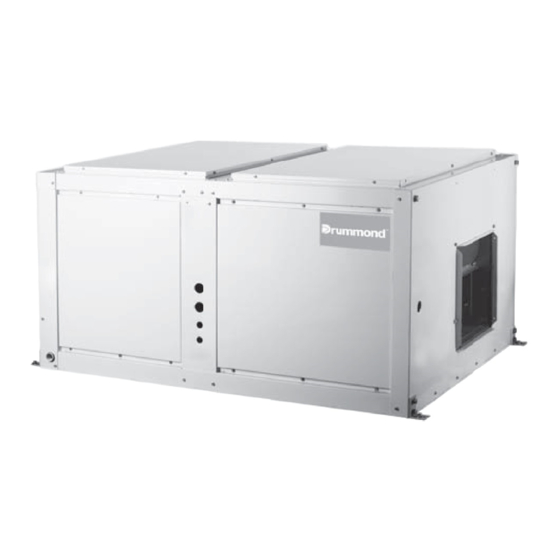Drummond MOV-90CN1-D Manuel d'installation - Page 11
Parcourez en ligne ou téléchargez le pdf Manuel d'installation pour {nom_de_la_catégorie} Drummond MOV-90CN1-D. Drummond MOV-90CN1-D 16 pages. Split system cooling only, r-410a refrigerant
Également pour Drummond MOV-90CN1-D : Manuel du propriétaire (11 pages)

Use refrigerant tank to expel air (see Fig.6-2 and Fig.6-3 )
Screw up the pipe nuts at A, B, C and D completely.
Loosen and remove the square-head cover and the mainte-
nance orifice nut of valves A and B.
Connect the filler hose of the refrigerant tank with the mainte-
nance orifice of valve A.
Loosen the valve of the refrigerant tank, continue filling refriger-
ant for 6 seconds to expel the air, and tighten the nut of valve B
quickly.
Loosen the valve of the refrigerant tank again, and fill the
refrigerant for 6 seconds. Detect leak for all adapters at A, B, C
and D. After making sure that no leak exists, screw off the filler
hose. After all the filled refrigerant is expelled, screw up the
maintenance orifice nut of valve A quickly.
Open the square-head spools of valves A and B completely.
Tighten the square-head cover of valves A and B.
Use a vacuum pump to expel the air (Fig.6-4 ): (For method of
using the manifold valve, see the operation manual of manifold
valve)
Loosen and remove the maintenance orifice nut of valve A, and
connect the filler hose of the manifold valve to the maintenance
orifice of valve A (tighten both valve A and valve B).
Connect the filler hose adapter to the vacuum pump.
Open the low pressure (Lo) handle of the manifold valve
completely.
Start the vacuum pump to extract air. At the beginning of
extracting air, slightly loosen the maintenance orifice nut of valve
B, check whether any air enters it (the vacuum pump noise
changes, and the multimeter indicates from negative to 0). Then
tighten this maintenance orifice nut.
Upon completion of vacuuming, tighten the low pressure (Lo)
handle of the manifold valve completely and stop the vacuum
pump. Keep extracting air for over 15 minutes. Check whether
the multimeter points at -1.0X10 Pa(-76cmHg).
Loosen and remove the square-head cover of valves A and B.
After opening valves A and B completely, tighten the square-
head cover of valves A and B.
Remove the filler hose off the maintenance orifice of valve A, and
then tighten the nut.
Manifold valve
Multimeter
-76cmHg
Lo-handle
Filler hose
Lo pressure valve
Installation Manual
10
Fig.6-3
manometer
Hi
-handle
Filler hose
Fig.6-4
Procedure of using stop valve
Open the spool until it touches the stop block. Do not attempt to
open further.
Use a spanner or a similar tool to tighten the bonnet. The bonnet
tightening torque is shown in aboveTable "Tightening torque".
Upon completion of installation, open all valves before trial run.
Each unit has two valves of different sizes located at the outdoor
unit side. Of the two valves, one is gas valve and the other is
liquid valve. The procedure of opening/closing the valve is
shown in the right figure (Fig.6-5).
Procedure of opening the valve: Open the square-head cover,
use a spanner to capture the square head and open it
thoroughly. Then tighten the square-head cover.
Procedure of closing the valve: Same as the procedure of
opening the valve, but rotate the spanner clockwise thoroughly.
Valve body
System port
6.5 Leak Detection
Use soap water or a leak detector to check whether gas leakage
exists at the adapters.
6.6 Heat Insulation
Use heat insulation materials to wrap the part protruding outside
the flared pipe joint and the refrigerant pipe of the liquid pipe and
the gas pipe, and ensure that no gap exists between them.
Imperfect heat insulation may lead to condensate drips.
7. INSTALL THE DRAIN PIPE
Install the drain pipe of the indoor unit
In order to prevent drain overflow, install a drainage controller at
place 1 of the drain pipe. (The drainage controller is designed to
smoothen the drainage when the static pressure outside the unit
is high, especially at the air inlet, in addition to remove stink
through the drain pipe.)
The drain of water is natural. In the construction, the external
pipe of the outdoor unit slants downward at a gradient of
1/50~1/100.
The number of bends and folds of the drain pipe should not
exceed 2. Try to avoid bends in order to prevent trash accumula-
tion.
In the construction, do not drop trash into the drip tray or drain
pipe of the indoor unit.
Upon completion of installing the drain pipe, remove the inspec-
tion panel. Put water into the drip tray to check whether the water
can be drained levelly and steadily.
Maintenance orifice
Connective pipe port
Fig.6-5
